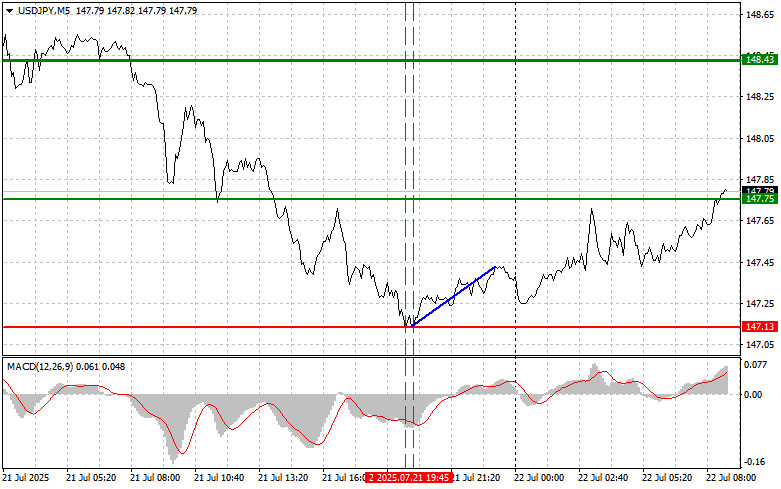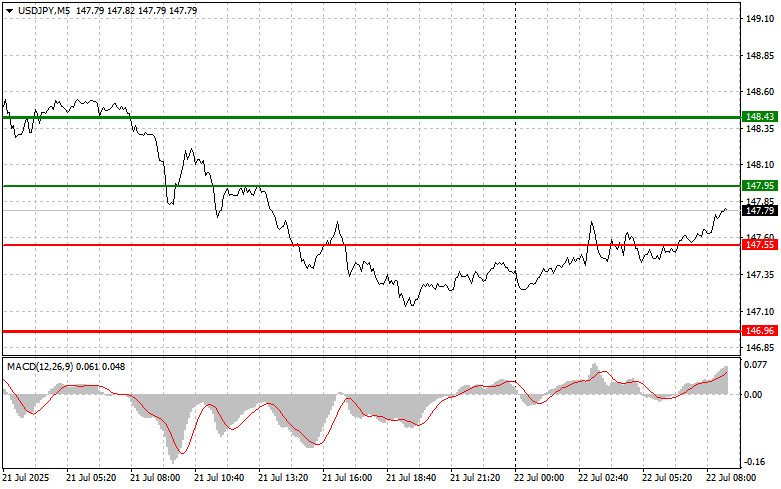Analysis of Trades and Trading Tips for the Japanese Yen
The first test of the 147.13 level occurred when the MACD indicator had already moved significantly below the zero mark, which limited the pair's downside potential. A short time later, another test of 147.13 occurred when the MACD was in the oversold zone, allowing for the implementation of Buy Scenario #2 for the dollar. As a result, the pair rose by 30 points.
The US dollar has weakened significantly against the Japanese yen in recent days. However, this is more due to the lack of demand for the dollar—after a strong rally against several global currencies—than to the yen's inherent strength. The expected softer stance of the Federal Reserve regarding interest rates is likely to continue to cap the upside in USD/JPY. Nevertheless, there is still no clear evidence of genuine yen buying. The market is increasingly leaning toward the view that the Fed will soon adopt a more dovish approach, which is putting pressure on the dollar. In turn, this creates headwinds for further strengthening of USD/JPY, as the interest rate differential between the US and Japan remains a key factor driving the pair. Trade disputes between the two countries and the lack of an agreement will continue to weigh on the yen in the short term.
Buy Scenario
Scenario #1: I plan to buy USD/JPY today upon reaching the entry point near 147.95 (indicated by the green line on the chart), targeting a rise to 148.43 (denoted by the thicker green line on the chart). Around 148.43, I intend to exit long positions and open shorts in the opposite direction (expecting a 30–35 point move in the opposite direction). It is best to buy the pair on pullbacks and deep corrections in USD/JPY.
Important: Before buying, ensure the MACD indicator is above the zero line and is just beginning to rise from it.
Scenario #2: I also plan to buy USD/JPY today in the event of two consecutive tests of the 147.55 level while the MACD indicator is in the oversold zone. This will limit the pair's downside potential and lead to an upward market reversal. A rise toward the opposite levels of 147.95 and 148.43 can be expected.
Sell Scenario
Scenario #1: I plan to sell USD/JPY today only after a breakout above 147.95 (red line on the chart), which could lead to a swift decline in the pair. The main target for sellers will be the 146.96 level, where I intend to exit short positions and immediately open long positions in the opposite direction (expecting a 20–25 point bounce from the level). Selling pressure on the pair could return at any moment today.
Important: Before selling, ensure the MACD indicator is below the zero line and is just beginning to decline from it.
Scenario #2: I also plan to sell USD/JPY today in the event of two consecutive tests of the 147.95 level while the MACD indicator is in the overbought zone. This will limit the pair's upside potential and lead to a downward market reversal. A drop toward the opposite levels of 147.55 and 146.96 may follow.
What's on the Chart:
- The thin green line represents the entry price where the trading instrument can be bought.
- The thick green line indicates the expected price level where a Take Profit order can be placed, or profits can be manually secured, as further price growth above this level is unlikely.
- The thin red line represents the entry price where the trading instrument can be sold.
- The thick red line indicates the expected price level where a Take Profit order can be placed, or profits can be manually secured, as further price decline below this level is unlikely.
- The MACD indicator should be used to assess overbought and oversold zones when entering the market.
Important Notes:
- Beginner Forex traders should exercise extreme caution when making market entry decisions. It is advisable to stay out of the market before the release of important fundamental reports to avoid exposure to sharp price fluctuations. If you choose to trade during news releases, always use stop-loss orders to minimize potential losses. Trading without stop-loss orders can quickly wipe out your entire deposit, especially if you neglect money management principles and trade with high volumes.
- Remember, successful trading requires a well-defined trading plan, similar to the one outlined above. Making impulsive trading decisions based on the current market situation is a losing strategy for intraday traders.














